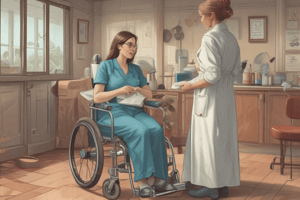Podcast
Questions and Answers
What is the primary goal of medication administration?
What is the primary goal of medication administration?
- To give medications to patients in a safe and effective manner (correct)
- To document the medication
- To implement a 'no interruption' zone
- To conduct regular medication audits
What is the normal range for blood pressure?
What is the normal range for blood pressure?
- 80-100 mmHg systolic, 50-70 mmHg diastolic
- 90-120 mmHg systolic, 60-80 mmHg diastolic (correct)
- 100-130 mmHg systolic, 70-90 mmHg diastolic
- 110-140 mmHg systolic, 80-100 mmHg diastolic
What is the first stage of wound healing?
What is the first stage of wound healing?
- Proliferation
- Inflammation (correct)
- Wound closure
- Debridement
What is a strategy to prevent medication errors?
What is a strategy to prevent medication errors?
What is the purpose of vital signs assessment?
What is the purpose of vital signs assessment?
What is the definition of vital signs?
What is the definition of vital signs?
What is a key principle in wound care?
What is a key principle in wound care?
What is a barrier to effective patient communication?
What is a barrier to effective patient communication?
What is the primary goal of infection control?
What is the primary goal of infection control?
What is a wound care intervention?
What is a wound care intervention?
What is a strategy to improve patient communication?
What is a strategy to improve patient communication?
What is a type of infection that can occur in healthcare settings?
What is a type of infection that can occur in healthcare settings?
Flashcards are hidden until you start studying
Study Notes
Medication Administration
- Definition: The process of giving medications to patients in a safe and effective manner.
- Rights of Medication Administration:
- Right patient
- Right medication
- Right dose
- Right route
- Right time
- Right documentation
- Steps of Medication Administration:
- Verify the medication order
- Prepare the medication
- Administer the medication
- Document the administration
- Common Medication Administration Errors:
- Omission
- Commission
- Unauthorized
- Wrong dose
- Wrong route
- Wrong time
- Strategies to Prevent Medication Errors:
- Use barcode scanning
- Implement a "no interruption" zone
- Use a "buddy" system
- Conduct regular medication audits
Vital Signs Assessment
- Definition: The process of measuring and recording a patient's basic physiological functions.
- Vital Signs:
- Temperature
- Pulse
- Blood Pressure
- Respiratory Rate
- Oxygen Saturation
- Normal Vital Sign Ranges:
- Temperature: 36.5-37.5°C (97.7-99.5°F)
- Pulse: 60-100 beats per minute
- Blood Pressure: 90-120 mmHg systolic, 60-80 mmHg diastolic
- Respiratory Rate: 12-20 breaths per minute
- Oxygen Saturation: 95-100%
- Importance of Vital Signs Assessment:
- Identifies changes in patient's condition
- Monitors response to treatment
- Detects potential complications
- Guides nursing interventions
Wound Care
- Definition: The process of promoting wound healing and preventing complications.
- Wound Healing Stages:
- Inflammation
- Debridement
- Proliferation
- Remodeling
- Wound Care Principles:
- Keep the wound clean and moist
- Promote a warm and moist environment
- Manage pain and discomfort
- Monitor for signs of infection
- Wound Care Interventions:
- Debridement
- Dressing changes
- Wound cleansing
- Topical treatments
- Pain management
Patient Communication
- Definition: The process of exchanging information and ideas with patients to promote health and well-being.
- Effective Communication Skills:
- Active listening
- Verbal and nonverbal communication
- Empathy and compassion
- Clarity and simplicity
- Cultural sensitivity
- Barriers to Effective Communication:
- Language barriers
- Sensory impairments
- Cognitive impairments
- Emotional barriers
- Environmental distractions
- Strategies to Improve Patient Communication:
- Use plain language
- Avoid jargon and technical terms
- Use visual aids and written materials
- Encourage patient participation
- Provide emotional support
Infection Control
- Definition: The process of preventing and controlling the spread of infections in healthcare settings.
- Types of Infections:
- Hospital-acquired infections (HAIs)
- Community-acquired infections
- Surgical site infections (SSIs)
- Central line-associated bloodstream infections (CLABSIs)
- Catheter-associated urinary tract infections (CAUTIs)
- Infection Control Measures:
- Hand hygiene
- Personal protective equipment (PPE)
- Isolation precautions
- Sterilization and disinfection
- Vaccination and immunization
- Strategies to Prevent Infection Transmission:
- Implement proper hand hygiene practices
- Use proper PPE
- Clean and disinfect surfaces and equipment
- Follow proper isolation precautions
- Monitor for signs of infection
Studying That Suits You
Use AI to generate personalized quizzes and flashcards to suit your learning preferences.




